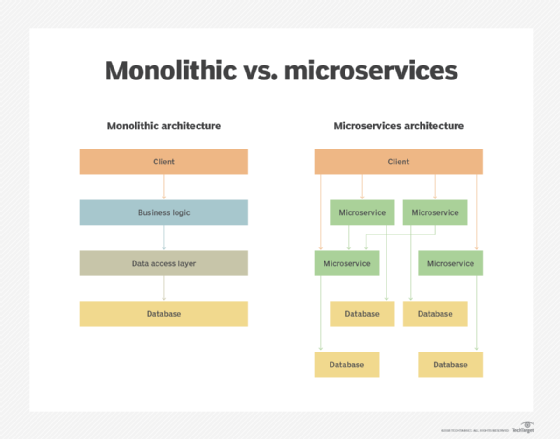Follow these 10 fundamental microservices design principles
The right design principles enable microservices adopters to build an application from autonomous, cohesive components that can scale seamlessly. Here are 10 to follow.
Leading organizations understand the benefits they can gain by migrating existing apps to a microservices architecture and adopting the approach for new builds. However, there are inherent challenges application designers, architects and developers face around scalability, performance and deployment.
Use these 10 key microservices design principles as guidelines to build applications that meet expectations and avoid short- and long-term lifecycle issues. They range from conceptual, such as how to define the scope of a service and maintain data autonomy, to practical, such as what patterns to use to maximize network traffic performance.
1. Ensure high cohesion and low coupling
Cohesion and coupling are two terms often used interchangeably when describing a microservices architecture. The former relates to the degree of intradependence that exists between the modules of an application, and the latter is used for the degree of interdependencies.
You should design microservices so that cohesion is high and coupling is low. This plan creates microservices that are adaptable to changes, scalable and can be extended over time.
This article is part of
What are microservices? Everything you need to know
The higher the cohesion, the better, because the modules work together. If cohesion is low, the application would send too many communications back and forth between the services, causing degraded performance and scalability.
Two components are loosely coupled when they are not interdependent, i.e., if they can function without the other and if any change in one component wouldn't break the functionality of the other. Loosely coupled components in an application should be easy to test because the component is isolatable.
2. Define the scope properly
You should define the functionality of a microservice, describing what it is intended to do. The scope of a microservice corresponds to the requirement of an independent business module. It's important to set a proper scope for each microservice in order to rationalize its size and define its boundaries.
3. Adhere to the Single Responsibility Principle
The Single Responsibility Principle states that a class should never have more than one reason for change. This principle is essential to designing a microservices-based application, because there should not be multiple responsibilities in a single microservice.
Create SOLID software
The term SOLID is a mnemonic acronym that corresponds to five design principles of software architecture:
- Single responsibility
- Open/closed
- Liskov substitution
- Interface segregation
- Dependency inversion
4. Design for failure
One of the objectives of microservice architecture is to create fault-tolerant and resilient software systems. Failure or performance issues in one service should not affect other services. A memory leak, database connectivity problems or other issues in one microservice should not bring the entire application down.
Since the services in a microservices-based application are autonomous and independent, they can take advantage of the circuit breaker pattern, which is a means to cut off communication with one or more services that are down or experiencing errors.
5. Build around business capabilities
Each microservice should be designed to solve a business problem. The developer can use the appropriate technology stack for each business problem in each microservice. Unlike a monolithic application, you are not constrained to use a single best-fit homogenous technology stack for the whole architecture. This microservices design principle means developers should choose what's best and readily available for use in every component of the application.
6. Decentralize data
Unlike in monolithic applications, microservices each maintain their own copy of the data. In other words, each microservice has its own database. You should not set up multiple services to access or share the same database, since it defeats the purpose of autonomous microservice operation.
Data pertaining to a specific microservice is private to that service. Use APIs to let other services access a microservice's owned data. This design principle enforces centralized access control and enables the developers to implement audit logging and caching seamlessly. Aim for one or two database tables per service.

7. Gear up process automation
A microservices design can deploy in several units, which the application team must manage. Automate the deployment process for microservices-based components via smart iterative release tooling, such as a CI/CD pipeline, potentially coupled with a DevOps culture.
8. Enable interservice communication
When you migrate an existing monolithic application to microservices, you must break apart many interrelated components; these services need a way to communicate. Microservices applications also enable diverse programming languages and approaches, as explained in the fifth microservices design principle, so an application might have services built with different technologies communicating with each other. APIs make it all work.
When you set up microservices APIs, abstract the implementation details of how a service works and only expose API methods to enable external access to the service. In this setup, a microservice can scale independently.
9. Monitor constantly
Microservices in production are distributed and interrelated. It is daunting to manually discover and identify errors. Instead, use an automated monitoring system that can track performance constantly. As part of the microservices design and deployment process, select a tool or set of tools that captures and analyzes data on services' performance, and generates useful metrics.
10. Manage traffic
Traffic to microservices in an application differs from one to the next. One service might have huge traffic while another is low-demand on the network. In each kind of traffic scenario, performance is an important factor. Take advantage of autoscaling and circuit breaker patterns to maximize performance.







